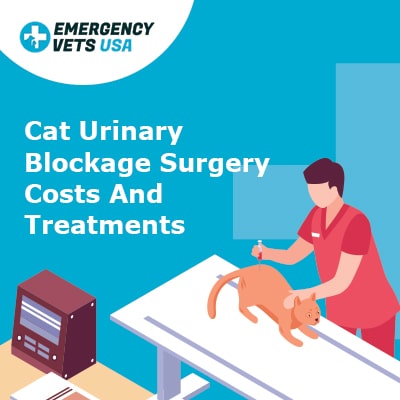Cat Urinary Blockage Surgery Costs And Treatments
 If you have a cat, you know how difficult it can be to know if something is wrong with them. Cats are great at hiding any sort of pain. They can even go for days with something being wrong without ever giving you a clue. Unfortunately, usually when cats start to act out of sorts, they have become very sick.
If you have a cat, you know how difficult it can be to know if something is wrong with them. Cats are great at hiding any sort of pain. They can even go for days with something being wrong without ever giving you a clue. Unfortunately, usually when cats start to act out of sorts, they have become very sick.
When we talk about a blockage in a cat, we are usually referring either to a urinary blockage or an intestinal (gut or bowel) blockage. Both of these scenarios are life-threatening situations. Both of them are also quite expensive to treat. We will discuss urinary blockage below and give you an idea of approximate costs as well.
Cat Urinary Blockage
Urinary blockage basically means that your cat is unable to pee (urinate). This is extremely dangerous and if left untreated, can cause them to die.
What Causes Urinary Blockage?
Urinary blockage can be caused by one or a combination of the following:
- Bladder & urethral stones
- Mucous plugs
- Untreated urinary tract infections
- Stress-induced spasm of the urethra
Male cats are at higher risk for urinary blockage, especially those that are overweight. It occurs more commonly in neutered male cats, but it can also happen to cats that are not neutered. Cats who have anxiety or high stress are also more at risk for getting a urinary blockage.
Signs that Your Male Cat Can’t Pee
Cats often show subtle signs that are hard to pick up on when they are having trouble. Because of that, many people feel that their cat developed a problem within a 24-hour time frame. Here are some things you should look out for that may indicate your cat could be blocked:
- Going in and out of the litter box frequently
- Meowing while in the litter box (if this is not normal for them)
- Straining to urinate
- Only urinating very small amounts each time they go
- Blood or discoloration to their urine
- Trying to urinate in spots outside of the litter box
- Licking under their tail near their penis often, especially after leaving the litter box
- Positioning to urinate but nothing is coming out
- Being lethargic or really tired
- Hiding
- Not eating
- Vomiting
- Painful abdomen
If you notice one or a combination of these signs in your cat, you need to schedule an appointment with your veterinarian as soon as possible. If your cat is not getting any urine out, you need to take them to an emergency vet right away.
Urinary Blockage Treatment Costs
This is not something that can be treated at home. Depending on the vet clinic you go to, they may have different protocols for treating blocked cats. There are typically three different options available, though the cheapest options may not be offered at every clinic. This is because the cheapest one is also the riskiest and the least likely to provide your cat with a good outcome. That being said, even cats treated with the most expensive option sometimes do not have good long-term outcomes.
Cheapest option, but least successful: $500-700
This treatment option requires the least amount of hospitalization. Your vet will sedate your cat, pass a urinary catheter to relieve the obstruction, and flush out your cat’s bladder. They will likely give an antibiotic, pain medication, and some fluids to help with hydration. Your cat will go home once they are properly awake from sedation.
This does not involve any x-rays, so you may miss a key piece of information if your cat has stones that are causing the obstruction. If they do have stones, they will likely re-obstruct in a few days or weeks.
More expensive option, more successful: $1500-3000
This treatment option requires about 2-5 days of hospitalization. Your vet will check blood work and x-rays on your cat prior to unblocking them. If no bladder or urethral stones are seen on the x-rays, they will sedate them and pass a urinary catheter to relieve the obstruction. They will flush out your cat’s bladder and suture (sew) the urinary catheter in place to maintain an opening for urine to escape your cat’s bladder.
Your cat will be given antibiotics, pain medication, fluids for hydration, and offered food. The vet will be monitoring your cat’s comfort level, urine color, and urine output each day to determine if and when the urinary catheter can be removed. This will help determine when your cat can go home. The longer your cat needs to stay, the more expensive their treatment will be. If your cat is at a hospital where they give intravenous (IV) fluids, it will also be more expensive than if they are at a clinic that just does daily fluids under the skin (subcutaneously).
Most expensive option, most successful: $3000-4500
The most expensive treatment option is a surgical procedure. This is usually reserved as a last resort, and only for the cats who continue to re-obstruct after they are treated as described above.
The surgery is called a perineal urethrostomy, or PU for short. It creates a new urinary opening, shortening the length of the urethra. It’s the procedure that is often referred to as “turning a male cat into a female cat”. This is usually performed by a qualified specialist surgeon, which is another reason why it can be so expensive. The good news is that it typically permanently resolves the issue. Your cat is very unlikely to re-obstruct later in life.
If you believe your male cat has a urinary blockage, you will need to contact your local vet immediately. This can be a life-threatening situation if it is not resolved quickly. The fact is that you may not know there is a problem until your cat has been blocked for a number of days.

Leslie Brooks graduated from the University of Tennessee College of Veterinary Medicine in 2012. After graduation she moved to Indianapolis to do an intensive one-year internship at a specialty practice and then began working as a small animal general practitioner. She ran her own house call practice for three years, visiting pets in people’s homes. Currently, she works part time in clinical practice and volunteering her free time to serve pets of the homeless. Read more about us here.
